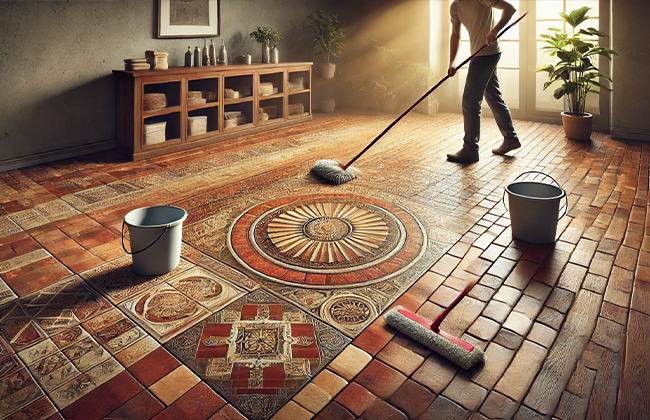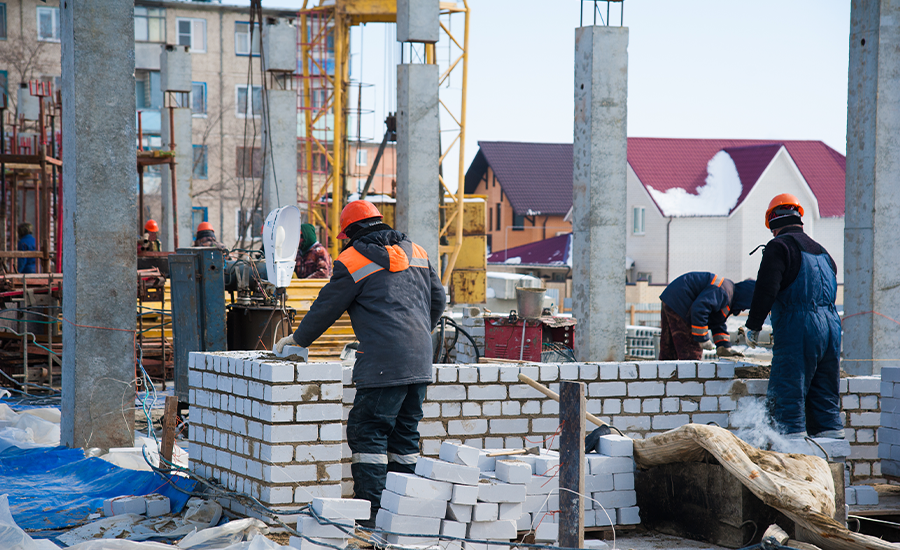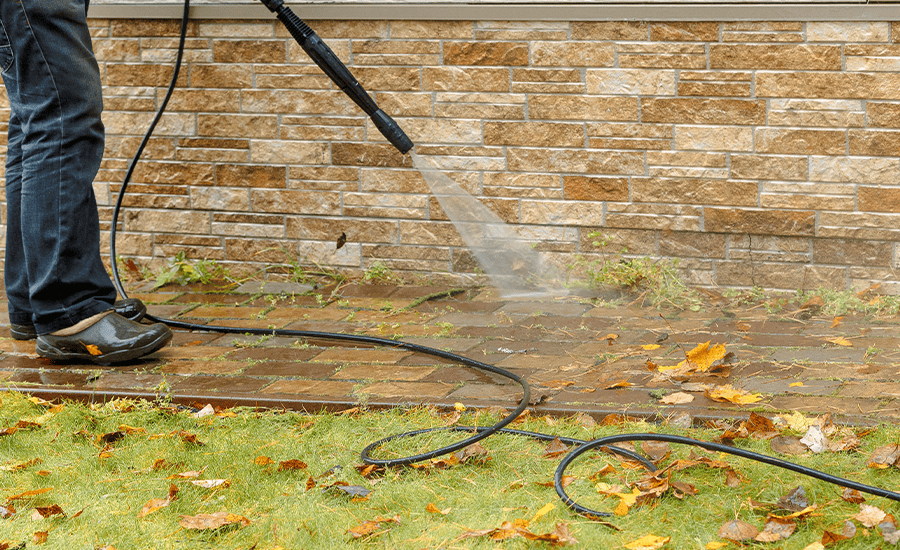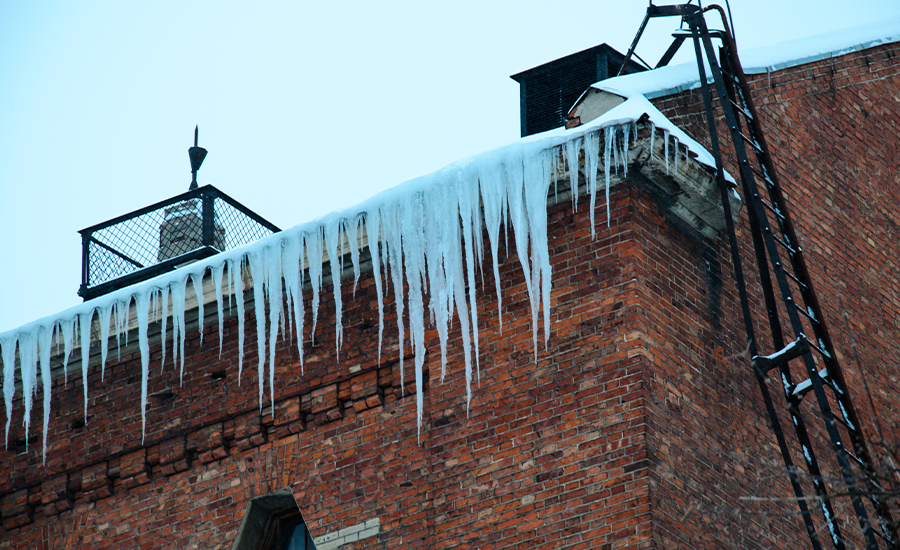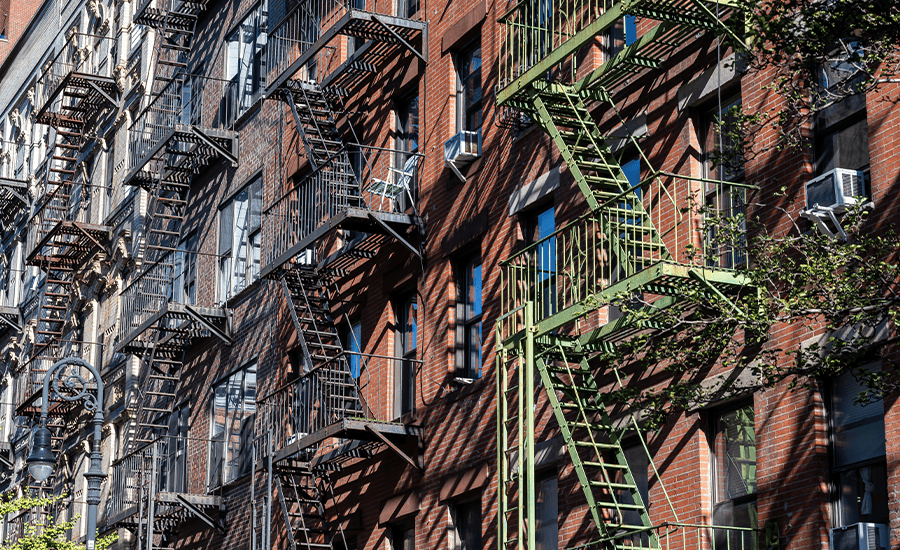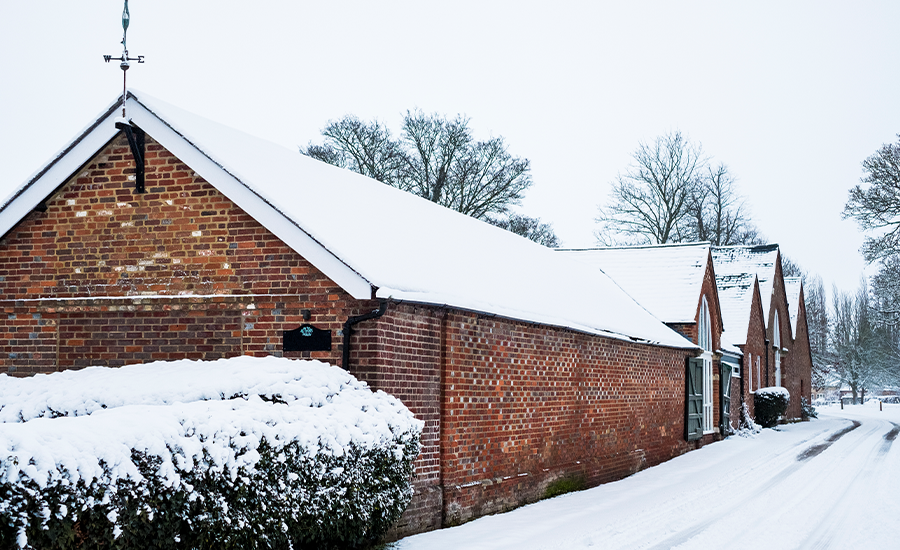Cleaning interior brick floors doesn’t have to be a daunting task. With the right techniques and some simple maintenance tips, you can effectively clean interior brick floors and keep them looking pristine. Whether it’s routine dusting, handling spills promptly, or engaging in periodic deep cleaning, this guide offers everything you need to maintain the beauty and longevity of your brick flooring. From basic daily care to more intensive treatments, we’ll cover all the essential steps to ensure your interior brick floors remain a highlight in your home.
Basics of Brick Floor Care
Caring for your brick floors isn’t rocket science, but it does need the right touch. Think of it as looking after a classic car; it’s all about regular maintenance and using the right products. These floors bring a unique, warm aesthetic to any space, blending durability with charm. But, just like any valued aspect of your home, they require specific attention to keep them at their best. In this section, we’ll break down everything from the makeup of brick floors to why keeping them clean is key for their longevity and beauty. Ready to get started?
Let’s learn what makes these floors tick and how to keep them ticking beautifully!
Composition and Characteristics
Brick floors aren’t just about good looks; they’re built tough! Made from natural clay and shale, these floors are fired at high temperatures, making them sturdy and able to withstand plenty of foot traffic. But here’s a fun fact: despite their toughness, brick floors are quite porous. This means they can absorb liquids and stains faster than you might say “Oops!”—unless they’re sealed properly, of course. Understanding what your brick is made of helps you figure out the best way to care for it. So, whether your floors are old-school clay or a modern mix, they all share a common need for gentle, effective cleaning methods.
Why Proper Cleaning Matters
Now, you might wonder, “Why fuss over cleaning brick floors specifically?” Well, here’s the scoop: proper cleaning isn’t just about keeping your floors looking snazzy—it’s about preserving them. Dirt and grit can act like sandpaper under shoes, wearing down the surface of your beautiful brick. Not to mention, spills left unattended can seep deep into the brick and cause stains that are a headache to remove. Regular cleaning keeps these problems at bay and extends the life of your floors, ensuring they continue to add that warm, rustic charm to your home for years to come.
Now that you’ve got a handle on the basics, let’s gear up for some pre-cleaning preparation. On to the next part!
Pre-Cleaning Preparation
Before you dive into scrubbing and wiping, a little prep work can make your cleaning session more effective and a lot less stressful. Think of it as the setup before the main event—it’s all about getting the right tools and understanding what your floors really need.
Assessing Your Brick Floors
First up, take a good look at your brick floors. Are they just dusty, or are we talking about serious grime here?
Identifying the level of dirt will help you decide how much elbow grease you’ll need. Check for any loose bricks or damaged mortar too. It’s much better to catch these issues early before they turn into bigger headaches. And hey, while you’re at it, why not make a little map of any stains or spots that need extra attention?
This way, you won’t miss a spot when you get down to business.
Gathering Necessary Supplies
Now, let’s talk gear. You’ll need a few basics:
- A sturdy broom or vacuum cleaner for dust and debris.
- Mild detergent or a specialized brick cleaner that won’t be too harsh on your floors.
- A scrub brush with stiff bristles, ideal for getting into all those nooks and crannies.
- Mops and buckets, preferably with a wringing feature to keep the water usage minimal—remember, too much water is a no-go for brick!
Rubber gloves to protect your hands. - Towels or rags for drying areas quickly to prevent any water from seeping into the brick.
Having these items on hand will streamline your cleaning process, ensuring you have everything you need within reach, reducing the run-around and doubling back.
Armed with the right tools and a solid plan, you’re all set to move into the nitty-gritty of daily cleaning practices. Let’s keep your brick floors looking their best, shall we?

Transform your home with expert masonry services. Contact us today for a free consultation.

Daily Cleaning Practices
Keeping your brick floors in top shape doesn’t need to be a chore. With daily cleaning practices that are simple and effective, you can maintain the beauty and longevity of your floors without breaking a sweat. Let’s walk through the steps that will keep those bricks looking bright and clean every day.
Sweeping Techniques
A good sweep does wonders, especially for brick floors. Start by choosing the right broom—something with stiff bristles is perfect for loosening dirt trapped in the crevices of the brick. Sweep in one direction to gather all the debris into one spot, making it easier to pick up. Here’s a pro tip: sweep your floors daily, especially in high-traffic areas. This prevents dirt accumulation that can scratch or wear down the surface over time. And don’t rush it! Taking your time to do a thorough sweep will set the stage for any additional cleaning that might be needed.
Vacuuming Tips for Brick Floors
If you prefer vacuuming, that’s great too! A vacuum can be a brick floor’s best friend, particularly if it has a brush attachment. Turn on that brush feature to gently agitate the dirt out from between the bricks and suck it up efficiently. When vacuuming, keep the machine on a low setting to avoid any harsh contact that could damage the bricks. Make sure to cover every inch—edges, corners, and under furniture, because dust loves to hide in those hard-to-reach spots.
By incorporating these daily cleaning practices, you’re not just cleaning; you’re caring for your floors, ensuring they stand the test of time and traffic. Ready to step it up a notch?
Let’s dive into some deep cleaning solutions that will tackle tougher jobs and restore the luster to your brick floors.
Deep Cleaning Solutions
While daily cleaning keeps your brick floors looking neat, every now and then they deserve a deep clean to restore their full glory. This section delves into the best homemade cleaning mixtures and what to look for in commercial cleaners, ensuring your floors not only get clean but stay in pristine condition.
Homemade Cleaning Mixtures
You don’t always need fancy products to get your brick floors sparkling. Sometimes, the best solutions are homemade and just as effective.
Here’s a simple recipe you can whip up with ingredients likely already in your kitchen:
Basic Brick Cleaning Solution:
- Mix equal parts water and white vinegar in a bucket.
- Add a squirt of mild dish soap for extra cleaning power.
- Stir the mixture gently to combine without creating too much foam.
Apply this solution using a mop or sponge, wringing it out well to avoid soaking the bricks. This mixture is great for breaking down grime without damaging the floor. After cleaning, be sure to go over the floor with clean water to remove any residue from the cleaning solution, and dry the area thoroughly with soft towels.
Commercial Cleaners: What to Look For
When opting for a commercial cleaner, it’s crucial to choose products that are safe for brick floors. Here’s what to keep in eye out for:
- pH-neutral cleaners: These are gentle on brick and won’t degrade the material over time.
- No harsh chemicals: Avoid cleaners that contain bleach or ammonia, as they can erode the surface of the bricks.
- Formulas designed for brick or stone: These are tailored to handle the porous nature of brick without causing damage.
Read labels carefully and always test a new cleaner on a small, inconspicuous area of your floor first. This ensures it won’t discolor or damage the brick.
By using the right deep cleaning solutions, whether homemade or commercial, you can tackle any dirt or buildup that daily cleaning might miss. Now, ready to address those stubborn stains?
Let’s move on to some effective stain removal techniques that will have your brick floors looking as good as new.

Transform your home with expert masonry services. Contact us today for a free consultation.

Stain Removal Techniques
When it comes to keeping your brick floors looking their best, tackling stains promptly and effectively is key. Let’s break down the types of stains you might encounter and provide targeted solutions to handle them like a pro.
Identifying Types of Stains
Stains on brick floors can come from various sources, and identifying them correctly can help you choose the best cleaning strategy. Here are a few common types:
- Organic Stains: These come from natural substances like food, mud, or leaves and typically leave a brownish mark.
- Inorganic Stains: Things like ink, dyes, or rust fall into this category and might need a different approach due to their chemical makeup.
- Oily Stains: Grease, cooking oil, or cosmetic products can leave slick marks that need special attention to remove completely.
Knowing what you’re dealing with helps in picking the right cleaner and method for the job.
Specific Solutions for Each Stain Type
Now that you know what kind of stain you’re up against, let’s talk solutions:
- For Organic Stains:
- Mix hydrogen peroxide with flour to create a thick paste.
- Apply the paste to the stain and cover it with plastic wrap overnight.
- The next day, scrape off the paste and rinse the area with water.
- For Inorganic Stains:
- Create a solution of water and muriatic acid (1 part acid to 10 parts water).
- Apply it carefully with a sponge, then rinse thoroughly after a few minutes.
- Always wear gloves and eye protection when handling acids!
- For Oily Stains:
- Sprinkle baking soda or cornstarch on the stain and let it sit for a few hours to absorb the oil.
- Vacuum up the powder, then clean the area with a dish soap solution to remove any residue.
Each of these methods tackles the unique properties of the stain type, ensuring that your brick floors get back to looking impeccable.
With those stains out of the way, let’s keep that momentum going by learning how to seal and protect your brick floors from future wear and tear.
Sealing and Protecting Brick Floors
Once your brick floors are clean and stain-free, the next step is sealing them to ensure they stay that way. Sealing isn’t just about making cleaning easier; it’s about protecting your investment and keeping those floors looking great for years to come. Let’s explore the benefits of sealing and how to choose the right sealant for your brick floors.
Benefits of Sealing Your Floors
Sealing your brick floors offers several advantages:
- Protection Against Stains: A good sealant acts as a barrier, preventing spills from penetrating the porous surface of the brick and becoming permanent stains.
- Ease of Cleaning: Sealed floors are smoother and less absorbent, meaning dirt and spills can be wiped away more easily without needing harsh chemicals.
- Enhanced Appearance: Sealants can bring out the natural color of your bricks and give them a subtle sheen, enhancing the overall look of your floors.
- Longevity: By protecting the bricks from wear and moisture, sealant extends the life of your floors, saving you money and hassle in the long run.
Choosing the Right Sealant
Selecting the right sealant for your brick floors is crucial for effective protection. Here’s what to consider:
- Type of Sealant: There are two main types—penetrating and topical. Penetrating sealants absorb into the brick and provide a natural finish while protecting from within. Topical sealants coat the surface and offer a glossier finish but may require more frequent reapplication.
- Compatibility: Make sure the sealant is suitable for brick. Some products are specifically formulated for brick and masonry, providing the best protection without damaging the material.
- Finish: Decide whether you want a natural look or a glossy finish. Penetrating sealants usually leave a matte finish, preserving the natural beauty of the brick, while topical ones can add gloss and enhance colors.
Always follow the manufacturer’s application instructions for the best results. Applying sealant might sound like a weekend project, but it’s pretty straightforward. With the right product and a bit of elbow grease, you can seal your floors efficiently and effectively.
Now that your floors are sealed, maintaining them becomes a breeze. Let’s keep the good vibes rolling and dive into some maintenance and care tips that will help your sealed floors stay looking fabulous.
Maintenance and Care
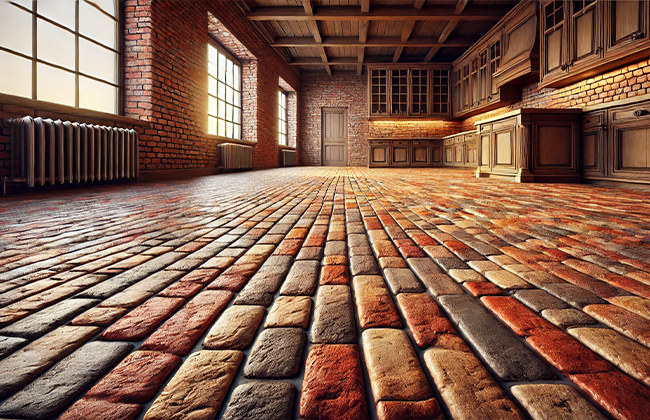
Now that your brick floors are sealed and protected, maintaining them becomes a breeze. Regular maintenance not only keeps your floors looking great but also prolongs their lifespan. Here’s how you can keep up with the care of your brick floors without turning it into a chore.
Routine Maintenance Tips
Maintaining brick floors is all about consistency and using the right techniques:
- Daily Sweeping: Regular sweeping prevents the buildup of dirt and grit that can scratch the surface. A soft-bristled broom is perfect for this job.
- Weekly Mopping: Use a damp mop with a mild cleaning solution once a week to remove any dirt that sweeping doesn’t get. Remember, the keyword here is ‘damp’—too much water can seep into the bricks and cause damage.
- Immediate Spill Cleanup: Accidents happen, but quick action can prevent stains. Blot spills immediately with a soft cloth to avoid liquid penetration.
- Re-Seal Periodically: Even the best sealant wears down over time. Check your floors annually and reapply sealant as needed to maintain their protective layer.
Avoiding Common Cleaning Mistakes
A little knowledge can go a long way in preventing damage during cleaning:
- Never Use Harsh Chemicals: Chemicals like bleach or ammonia can erode brick surfaces. Stick to pH-neutral cleaners specifically designed for brick.
- Avoid Abrasive Scrubbing Tools: While it might be tempting to scrub hard to remove stubborn stains, abrasive tools can scratch and damage brick. Use a soft brush if needed.
- Don’t Overwet the Floor: Excessive water is a big no-no for brick floors. It can weaken the mortar and lead to moisture-related issues like mold.
By following these simple maintenance and care tips, you can keep your brick floors in top condition without much fuss. Remember, a little preventative maintenance goes a long way in avoiding bigger problems down the line.
Speaking of problems, let’s move on to troubleshooting common issues that might arise with brick floors and how to handle them effectively.
Troubleshooting Common Issues
Even with the best care, brick floors can sometimes face issues that require a bit more attention. Dealing with mold and mildew or repairing cracks doesn’t have to be a nightmare. Here’s how to tackle these common problems effectively, ensuring your floors stay healthy and beautiful for years to come.
Dealing with Mold and Mildew
Mold and mildew can be a real pain, especially in damp areas of your home. Here’s how to combat these unwelcome guests:
- Identify the Source: First things first, figure out why there’s moisture on your floors. It could be anything from high humidity to a leaking pipe. Fixing the source of moisture is key to preventing future growth.
- Clean It Up: Use a solution of water and white vinegar (avoid bleach as it can discolor the brick) to clean the affected areas. Apply the solution with a sponge or brush, scrub gently, and let it sit for a few minutes before rinsing with clean water.
- Dry Thoroughly: After cleaning, make sure the area is dried completely. Use fans or dehumidifiers to help remove any lingering moisture.
Repairing Cracks in Brick Flooring
Cracks can appear due to settling, impact, or wear and tear. Here’s how to repair them:
- Clean the Crack: Remove any loose debris from the crack using a vacuum or a soft brush. This helps the repair material adhere better.
- Choose the Right Filler: For small cracks, a caulk made for masonry can be an easy fix. For larger cracks, you may need a concrete patching compound.
- Apply the Filler: Use a putty knife to press the filler into the crack, ensuring it’s filled completely. Smooth it over so it’s flush with the rest of the floor.
- Let It Cure: Follow the manufacturer’s instructions for drying or curing time. Once it’s set, you can paint or seal the area to match the rest of your floor.
By keeping an eye on these issues and addressing them promptly, you can maintain the integrity and appearance of your brick floors. But sometimes, a problem might be too big to handle on your own. When that happens, it’s okay to call in the professionals. Let’s explore when and why you might need professional cleaning services to help keep your brick floors in tip-top shape.

Transform your home with expert masonry services. Contact us today for a free consultation.

Professional Cleaning Services
Sometimes, despite your best efforts, your brick floors might need a little extra TLC that only professionals can provide. Knowing when to call in the experts and what to expect from professional cleaning services can save you time and ensure your floors get the best care possible.
When to Call the Professionals
Here are a few scenarios where professional help might be your best bet:
- Deep Stains and Accumulated Grime: If you’ve tried every DIY method and your floors still look lackluster or stained, it might be time to call in the pros.
- Post-Renovation Clean-up: Construction can leave behind tough-to-clean dust and debris that might be overwhelming for a regular cleaning routine.
- Specialized Treatments: Sometimes, your floors might need specific treatments, like steam cleaning or stain-proofing, that require professional equipment and expertise.
- Regular Maintenance: Setting up a routine professional cleaning can help preserve the longevity and beauty of your floors, especially in high-traffic areas.
What to Expect from Professional Cleaning
Professional cleaning services can offer a lot more than your standard mop and bucket approach:
- Thorough Assessment: Professionals will start by assessing the condition of your floors to determine the best cleaning methods and products.
- Advanced Techniques: They might use high-grade equipment and techniques like steam cleaning, deep scrubbing, and specialized sealing.
- Detailed Cleaning: Expect every nook and cranny to be tackled, including grout lines and hard-to-reach areas that you might have missed during regular cleanings.
- Advice and Recommendations: Beyond just cleaning, professionals can provide advice on how to maintain your brick floors and prevent future issues.
Choosing the right professional service is crucial. Look for companies with good reviews and proven experience in handling brick floors. A reliable service will be transparent about their methods and happy to discuss their approach with you before starting the work.
Now that your brick floors are professionally cleaned, let’s explore some additional tips and tricks to enhance their appearance and ensure they continue to add charm and value to your home. Let’s dive into enhancing your brick floors!
Enhancing Your Brick Floors
Now that your brick floors are clean and well-maintained, let’s talk about taking them to the next level. Enhancing your brick floors not only boosts the aesthetic appeal of your space but also adds to the overall value of your home. Here’s how you can make your brick floors shine brighter and last longer.
Decor Tips for Brick Floors
Brick floors provide a rustic, charming base that can complement a variety of decor styles. Here are some tips to make them pop:
- Area Rugs: Adding area rugs can soften the look of brick floors and add a touch of warmth and color. Choose rugs that complement the brick color and the room’s overall theme.
- Furniture Choices: Opt for furniture with rich, natural materials like wood or leather, which pair beautifully with brick. Light-colored furniture can also contrast nicely against darker bricks, creating a striking visual effect.
- Accent Colors: Use accent colors in your decor that enhance the natural hues of the brick. This can be in the form of throw pillows, art, or decorative items.
- Lighting: Proper lighting can dramatically enhance the look of your brick floors. Warm, soft lighting can highlight the texture and color variations in the brick, making the space feel cozy and inviting.
Long-term Care Strategies
To ensure your brick floors continue to look their best for years to come, consider these long-term care strategies:
- Regular Sealing: Depending on foot traffic and wear, reseal your floors every few years to maintain their protective barrier and enhance their appearance.
- Gentle Cleaning Products: Stick to pH-neutral cleaners and avoid harsh chemicals that can strip sealants and damage the brick.
- Prompt Attention to Spills: Quick response to spills and stains can prevent permanent damage. Keeping cleaning supplies handy can help address accidents swiftly.
- Professional Assessments: Schedule periodic assessments with a flooring professional to identify any potential issues like loose bricks or crumbling mortar before they become major problems.
By implementing these decor tips and long-term care strategies, you’ll ensure that your brick floors remain a beautiful and durable part of your home. So, enjoy the unique charm and character they bring to your living space, knowing they’re well cared for and stylishly showcased!
Conclusion
Maintaining clean interior brick floors enhances not only the aesthetics of your home but also the longevity of the floors themselves. With proper care, regular cleaning, and the occasional deep clean, your brick floors can remain a beautiful and durable part of your living space. If you’re seeking professional assistance to clean interior brick floors, don’t hesitate to contact us at (+1) 917-355-8556 for expert services tailored to your needs.
FAQs
Q: What’s the best method to clean interior brick floors?
A: The best way to clean interior brick floors involves regular sweeping, gentle mopping with a pH-neutral cleaner, and immediate attention to spills to prevent stains.
Q: Can I use vinegar to clean my interior brick floors?
A: Yes, diluted vinegar can be effective for cleaning interior brick floors. However, it should be used sparingly as acidic solutions can sometimes damage the sealant over time.
Q: How often should interior brick floors be sealed?
A: Interior brick floors should be resealed every few years, depending on foot traffic and the wear they experience, to maintain their appearance and durability.
Q: What are the common mistakes to avoid when cleaning interior brick floors?
A: Avoid using harsh chemicals and excessive water on interior brick floors as these can damage the bricks and the mortar, leading to long-term issues.
Q: Are professional cleaning services necessary for interior brick floors?
A: While regular maintenance can be handled at home, professional cleaning services can offer deep cleaning and specialized care for interior brick floors, especially when dealing with stubborn stains or when applying sealant.
Q: How to clean an indoor brick floor?
A: To clean an indoor brick floor, start by sweeping away any loose debris. Then, mop the floor using a mild detergent mixed with warm water, ensuring you wring out the mop well to avoid excess moisture.
Q: What cleaner to use on interior brick?
A: Use a pH-neutral cleaner designed for stone and tile. This will effectively clean the brick without damaging it. Avoid acidic cleaners like vinegar unless they are heavily diluted.
Q: What is the best tool to clean brick floors?
A: A soft-bristle brush or broom is ideal for cleaning brick floors as it can remove dirt from the textured surface without scratching the bricks. For mopping, use a microfiber mop for best results.
Q: What can I use to clean the inside of my fireplace brick?
A: For cleaning the inside of a fireplace brick, create a paste using baking soda and water. Apply it to the bricks, let it sit for a few minutes, then scrub gently with a scrub brush and rinse with warm water.
Q: How do I keep the inside of my fireplace clean?
A: Regularly remove ash and soot buildup with a vacuum designed for ash or a brush and dustpan. For deeper cleaning, use a mixture of warm water and mild dish soap to scrub the bricks, then rinse thoroughly.
Q: What are the best practices to clean interior brick floors after a spill?
A: To effectively clean interior brick floors after a spill, blot the spill immediately with a dry, absorbent cloth. Follow up with a mild cleaning solution suitable for brick and mop the area gently to avoid seeping moisture into the bricks.
Q: Can steam cleaning be used to clean interior brick floors?
A: Yes, steam cleaning is a great method to clean interior brick floors as it efficiently removes dirt and grime without harsh chemicals. However, it’s important to ensure that the brick is sealed properly beforehand to prevent moisture penetration.
Q: What should I avoid using when I clean interior brick floors?
A: Avoid using acidic or abrasive cleaners when cleaning interior brick floors as they can damage the brick’s surface. Stick to pH-neutral solutions and soft cleaning tools like microfiber mops to protect your flooring.
Q: How frequently should I clean interior brick floors in high-traffic areas?
A: Interior brick floors in high-traffic areas should be swept daily to remove debris and dust, and mopped with a suitable cleaner weekly to keep them in optimal condition and prevent buildup of grime.

Transform your home with expert masonry services. Contact us today for a free consultation.


